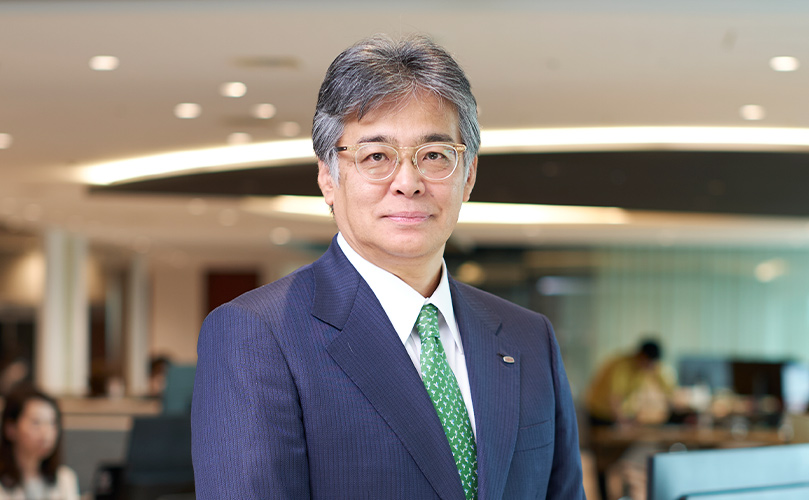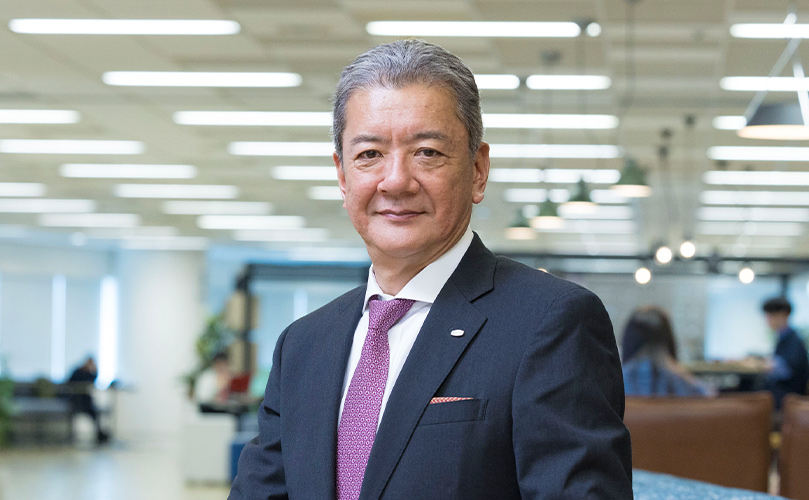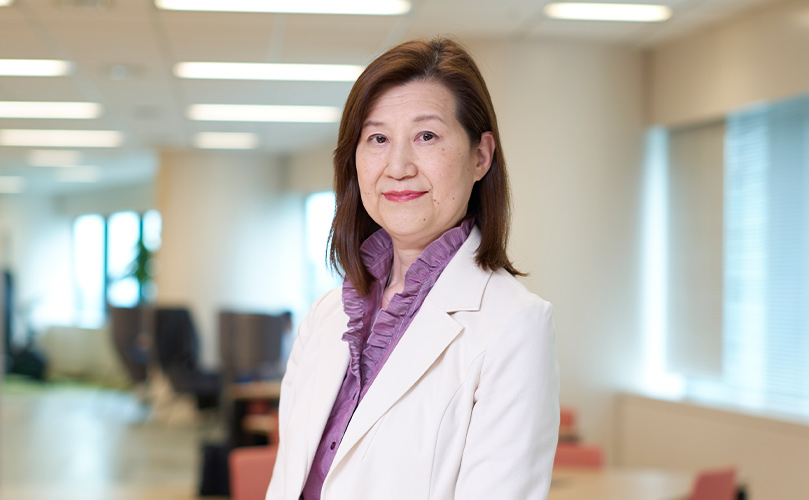Takahito Tokita
Representative Director
CEO
Message from the CEO

Working to realize net positive in 2030
The Fujitsu Group’s Purpose is “to make the world more sustainable by building trust in society through innovation.” In May 2023, we clarified the three essential areas of contribution for achieving Our Purpose as solving global environmental issues, developing a digital society, and improving people’s well-being. We have also established our value creation concept looking ahead to2030 as a vision of “being a technology company that realizes net positive through digital services.”
The expression “net positive” incorporates our determination to create positive outputs that exceed the negative outputs generated by our business activities. One example is supercomputers. Increasing computing power involves increasing electricity consumption but, on the other hand, exponential advances in computing power can also be used to generate innovations that contribute to reducing greenhouse gas (GHG) emissions. By driving technology and innovation through our business, we aim to create positive impacts on our customers and our society in the future.
Formulation of new Materiality as a response to stakeholders
We have identified three areas for the Fujitsu Group’s essential contributions (Materiality ): solving global environmental issues, developing a digital society, and improving people’s well-being. We chose 2023 as the time to identify our Materiality because we wanted to review our business management since the renewal of the Fujitsu Way based on Our Purpose in 2020, and to closely examine what kind of value we ourselves should provide to society, as well as what our customers expect from us.
In identifying our Materiality, we were careful to avoid complacency. We sought feedback from a wide range of stakeholders, centered on customers, employees, and shareholders, then had deep discussions based on the results to determine which of the various social issues are in areas inherently suitable for the Fujitsu Group to address. Personally I feel great confidence not only in the Materiality that we identified through these discussions, but also in the fact that our discussion process had the approval of our outside directors and Audit & Supervisory Board members.
I think that realizing net positive by 2030 expresses the Fujitsu Group’s commitment to creating value and, at the same time, it is the Group’s response to the stakeholders who helped to identify our Materiality. Our Values under the Fujitsu Way are Aspiration, Trust, and Empathy. It is highly significant that Empathy is the basis on which we set our targets and goals. This has reinforced my resolve to continue leading the Group as CEO while engaging sincerely with stakeholders.
Review of the 2020–2022 medium-term plan (the previous medium-term plan)
To realize Fujitsu’s ideal state in 2030, we have announced the milestones we wish to achieve for fiscal 2025 and the accompanying strategies in our new 2023–2025 Medium- Term Management Plan (medium-term plan) . Before I talk about these, I would like to report on our progress up to the end of fiscal 2022 and the issues we still need to address.
In our consolidated financial results for fiscal 2022, operating profit reached a record high and the operating profit margin reached 9.0%. However, in the Technology Solutions segment, both revenue and operating profit margin fell short of the financial targets of the previous medium-term plan.
External factors such as semiconductor shortages and foreign exchange fluctuations certainly had an impact on revenues and costs. However, these impacts could have been mitigated if we had swiftly promoted data-driven management and precisely executed demand prediction and inventory management. Another issue was that the plan envisaged growth in hardware products, which are more susceptible to supply chain risks than services are. These issues have been reflected in the new medium-term plan, which I will discuss later.
On the other hand, we are proud to have successfully launched Fujitsu Uvance as a solution to drive the Group’s medium- to long-term growth. Furthermore, among our non-financial targets , we achieved our targets for Customer Net Promoter Score (NPS®)*1 and digital transformation (DX) promotion as a result of our initiatives on the non-financial front. We did not hit our target for employee engagement, but we did improve our score, and I feel that the Group has undergone a major transformation in its systems and organizational culture, including the transition to job-based human resource management in Japan. I have to thank our employees for this, as they correctly understood the objective of the transformation and actively engaged in making changes amid the turmoil of the COVID-19 pandemic.
*1 Net Promoter® and NPS Prism® are registered trademarks of Bain & Company, Inc., Satmetrix Systems, Inc., and Fred Reichheld, and Net Promoter SystemSM and Net Promoter ScoreSM are service marks of Bain & Company, Inc., Satmetrix Systems, Inc., and Fred Reichheld.
Pursuing growth through four key strategies
Under our new medium-term plan, we are aiming for growth directed toward achieving Fujitsu’s ideal state in 2030 and maximizing our net positive outcome. To achieve these goals, we are promoting three themes: transform the business model and portfolio, ensure reliable support for customer modernization, and improve the profitability of our international businesses. Moreover, to promote these themes, we have formulated four key strategies : a business model and portfolio strategy, a customer success/regional strategy, a technology strategy, and a people strategy. By executing these strategies, we intend to achieve financial and non-financial targets for fiscal 2025 as follows: our financial targets are revenue of ¥4.2 trillion, adjusted operating profit*2 of ¥500.0 billion, adjusted operating profit margin of 12%, core free cash flow*3 of ¥300.0 billion, and earnings per share (EPS) with a compound annual growth rate (CAGR) of 14%–16%. Our non-financial targets are to reduce GHG emissions and improve on four indicators, namely Customer NPS, per capita productivity, employee Engagement, and the ratio of female managers.
*2 An indicator that represents actual profit from the core business calculated by deducting profits from business restructuring, M&A, etc., and one-off profits from changes in regulations from operating profit. (Previously presented as operating profit excluding special items.)
*3 Current FCF after deducting temporary income and expenses associated with business restructuring, M&A, etc.
Clarification of growth areas through changes to business segments
As part of our business model and portfolio strategy, we decided to make some changes to our business segments from fiscal 2023, by separating the previous Technology Solutions segment into the Service Solutions segment and the Hardware Solutions segment. The Service Solutions segment comprises global solutions and the services business that is delivered in each region (Japan and International).
The purpose of the segment changes is to enable a more rigorous execution of the management approach that matches our growth strategies and organizational structure to the segment classification for disclosing information. Clearly distinguishing our Service Solutions segment based on our growth-leading Fujitsu Uvance initiatives from our other businesses will enable us to better present our actual growth potential to our stakeholders. This is the answer that we came up with after reflecting on our previous medium-term plan, where our results in growth areas had become difficult to demarcate because the impacts of hardware supply shortages were also incorporated in the Technology Solutions segment that included service and solution businesses.
Focus on growth of Fujitsu Uvance’s Vertical areas
Under our new medium-term plan, we will accelerate growth and increase profitability centered on Service Solutions. The main driver for this is Fujitsu Uvance , which is comprised of seven Key Focus Areas. Four of these are cross-industry Vertical areas that provide solutions for social issues, and three are Horizontal areas that support them as a technology foundation. By the start of fiscal 2023, we were on track to have offerings in all seven Key Focus Areas. Over the next three years, we will refine our offerings, particularly in the four Vertical areas, working to create high added value, while at the same time investing in bolstering our consulting capabilities, developing strategic alliances, strengthening our technology foundation, and developing and reskilling human resources. In this way, we will establish a path for medium- to long-term growth.
The three defining characteristics of Fujitsu Uvance are that it starts with societal issues, takes a cross-industry approach, and includes digital services deployed on the cloud. For example, we have a strong share of the electronic medical record market for hospitals in Japan. The current services are mainly standalone systems that are complete within each individual hospital. As a Fujitsu Uvance solution, our offering will be used for cooperation between hospitals, and in regional healthcare and local government services, as well as in drug discovery and in creating value across business types and industries.
Until now, the Fujitsu Group’s business has operated on the basis of resolving individual customer’s issues. It is this experience that enables us to see a significant white space that exists between customers, and at the border between businesses. We have designed Fujitsu Uvance as a cross-industry initiative so that it can create business opportunities in exactly this white space. Some social issues, such as supply chain optimization and achieving carbon neutrality, cannot be resolved by the businesses of individual companies. By providing services that help to attain the resolution of such issues, we will realize a completely new level of growth and the transformation of our business portfolio toward 2030.
Capturing the business opportunities that exist in the white space requires proposals based on a profound understanding of customer needs and issues. We will therefore enhance our consulting capabilities for resolving customer issues under the customer success strategy of the new medium-term plan. Specifically, we will increase the number of personnel with consulting skills from 2,000 at the end of fiscal 2022 to 10,000 by fiscal 2025, combining both technology consultation and business consultation.
Modernization with a mission
While on-cloud services centered on Fujitsu Uvance will lead our growth, we will also focus on services that support our customers’ utilization of their IT assets. The mainstay of this activity is modernization, which mainly refers to shifting customers’ unique on-premises IT assets to the cloud.
The Fujitsu Group has decided to terminate sales and maintenance services of mainframe computers and UNIX servers, which are used by many customers in Japan. While we will continue to provide full support services so that customers can use these systems with confidence over the period until maintenance services are terminated, we also consider it our mission to promote modernization to support customers’ sustainable management. Over the three years until fiscal 2025, we will strengthen our delivery structure and make further progress on productivity, which was improved under the previous medium-term plan, and meet the demand for modernization, which we expect to peak in 2026, with a fully prepared structure.
Strengthening profitability with globally competitive offerings
In our regional strategy , in Regions ( Japan) we have set an ambitious target for fiscal 2025 of an adjusted operating profit margin of 19%, and we will promote Fujitsu Uvance and modernization. In other regions, where our adjusted operating profit margin was at the low level of 1% in fiscal 2022, we will work to improve profitability by expanding our provision of global offerings centered on Fujitsu Uvance.
In regions outside of Japan , we promoted a shift to the service business during the previous medium-term plan and in the Americas, in particular, we succeeded with major structural reforms. Furthermore, performance of Fujitsu Uvance in fiscal 2022 demonstrates how a global offering can be a catalyst for breakthrough growth. Among the seven Key Focus Areas, the one that recorded the highest revenue was one of the Horizontal areas, Digital Shifts, which is the area of the digital workplace. This involved providing the technologies and expertise employed by the Group in promoting its internal “Work Life Shift” transformation to external customers, where the overseas market in particular proved to be a notable growth driver. To catch up with the pace of growth of the overall Fujitsu Group, we will provide Fujitsu Uvance to regions outside of Japan as well, focusing particularly on the provision of offerings in Vertical areas, and accelerating our growth in stages.
In light of the recent occurrence of information security incidents and system quality issues, we are working across the Group to step up our security and quality management structure . As part of this, we will strengthen the functions of the Risk Management & Compliance Committee, of which I am the chair, and bolster our information security countermeasures under the guidance of our CISO (Chief Information Security Officer), whose authority has been increased. In addition, we will work on improving system quality and preventing recurrences under the newly appointed CQO (Chief Quality Officer).
Five Key Technologies and practical knowledge as the source for providing added value
We have identified five technology domains as the Key Technologies that support Fujitsu Uvance, and have concentrated our research and development resources in them under our technology strategy . One of these domains is AI, which has achieved amazing advances in recent years, and is now spreading rapidly in the form of corporate and consumer services. We welcome such flourishing of technology because it encourages people to proactively use cutting-edge technologies, actively accept new transformative technologies and try them out.
The Fujitsu Group has developed in-house technologies that support AI, in which we have over 30 years of accumulated research, as well as world-leading computing power, and technologies such as high-precision simulations, networks that also support large-scale social infrastructure, and cybersecurity. We also hold intellectual property , including patents, for these technologies. I think there are only a few companies in the world that can boast the same breadth of technological capabilities essential for providing digital services.
In addition, we have accumulated practical knowledge about how to convert these technologies into value. For example, under the OneFujitsu Program , we have introduced business applications that we provide through Fujitsu Uvance within the Group while promoting operational reforms in our business. We use the lessons and knowledge gained from this as a reference model when providing services to customers. The capabilities that we have obtained through technological development and implementing our own transformation are the competitive advantage of the Fujitsu Group.
Human resource portfolio transformation linked to business strategy
To accelerate our business portfolio transformation and produce results, it is essential to have a robust management foundation that enables the utilization of human capital and data. Under our people strategy , we will continue to transform our human resource portfolio and to advance data-driven management.
Human capital management , in particular, is one of the areas that I am focusing my energy on. As CEO of the huge team that is the Fujitsu Group, I believe that my role is to lead without leaving anybody on the team behind. Through a series of human resource management improvements that we initiated during the previous medium-term plan, employees’ mindsets are changing at the individual level, as well as at the level of organization culture, and this is showing in the results of the employee engagement survey. I feel a great sense of achievement that we are able to foster job satisfaction among our employees, even without the “membership” style human resource system traditionally used in Japanese companies. We will work to enhance our management foundation in terms of human resources and IT so that we can demonstrate successful models of human capital management and data-driven management.
Being a partner that can support sustainability transformation
Amid calls for the construction of a new economic system predicated on the sustainability of global society, including carbon neutrality, companies seeking to achieve sustainable growth will need to undergo not only a digital transformation but also a sustainability transformation so that they can create value in new and different ways. After completing the new medium-term plan in fiscal 2025, I see the Fujitsu Group working to encourage many customers to undertake a sustainability transformation, using Fujitsu Uvance as a starting point. As a technology company, it is our mission and our responsibility to provide our customers with powerful support as they participate actively in the building of a new economic system, and embark on their sustainability transformations with a determination and readiness to take on the challenge of creating value.
We are firmly resolved to achieve our financial and non-financial targets through the four key strategies of the medium-term plan, and to show the world that we are a company that will “make the world more sustainable by building trust in society through innovation.” We hope that you will share in our expectations for Fujitsu’s future endeavors.
Takahito Tokita
Representative Director
CEO









